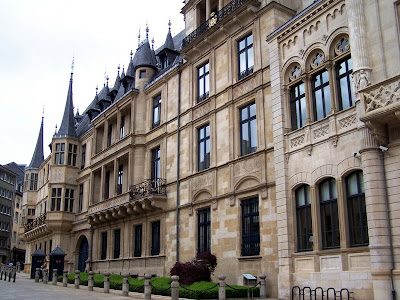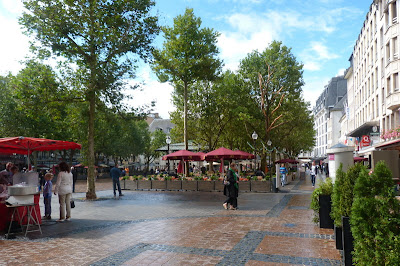Luxembourg is one of the world’s smallest countries, tucked in
between Belgium, France and Germany. Luxembourg
is a Grand Duchy, the only one in the world. There are three official
languages: French, German, and Luxembourgish. Nearly 90% of
Luxembourgers are Roman Catholic. We
visited the capital, Luxembourg City and the nearby American Military Cemetery.
LUXEMBOURG
CITY
The city of Luxembourg is known as the
landlocked “Gibraltar of the North” because of its once-fortified
position. It is set above the cliffs
that flank the canyon-like valleys of the Alzette and Petrusse rivers. Today the city is more fairy tale than
fortress, but its elegant towers, spires and turrets and its attractive walls
of golden sandstone helped the city win designation as a UNESCO World Heritage
Site.
We started our walking tour at
the Place de la Constitution, which offers
a nice view of the Perusse Valley and the impressive bridge that spans it. The tall Monument
du Souvenir in the center of the square is a memorial to those who have
perished in wars.

The great cliffs of the Petrusse and Alzette valleys
are honeycombed with tunnels, stairways, and chambers called the Casemates, hollowed out of rock during
the 17th and 18th centuries. Originally, the network of Casemates measured
over 14 miles and accommodated thousands of soldiers, as well as their horses
and supplies. Today, only about 10 miles
survive.
The Cathedral de Notre Dame (Cathedral
of Our Lady) was built between 1613 and 1621; its steeples form a striking part
of the city’s skyline. It is gothic in
design, but has a Renaissance-style entrance.
It holds the royal family vault and has a beautifully painted
ceiling.

Near the cathedral is a bronze statue of Charlotte, Grand Duchess of Luxembourg from 1911-1964.
The Grand
Ducal Palace is home to Grand Duke Jean of Luxembourg. The building is a much-renovated and extended
replacement of a medieval town hall that was destroyed by fire in 1554. The
oldest part of the building dates back to 1572, while the “new” right wing was
built in 1741.
Luxembourg City’s Old Town lies between the Grand Duke’s Palace and the high cliff of
the Alzette River. The area is small,
lying within narrow streets and squares, with the feeling of medieval
times. It once was the heart of the
community outside the castle walls.
The Place Guillaume II is the town square
in the heart of the old city. It is home
to the City Hall and an equestrian statue of the former Grand
Duke William II.
The Place
d’Armes is a second square in the old town, originally used as a parade
ground for troops defending the city.
Today, it’s a pedestrian zone, surrounded by cafes and restaurants. We visited one of these for a delicious lunch
of quiche, salad and crème brulee.
Yum.
We also stopped at the U.S. Military Cemetery, just outside of the city. It was established in December 1944 by the U.S. Third Army while Allied Forces were stemming the enemy's desperate Ardennes Offensive, one of the critical battles of World War II. The city of Luxembourg served as headquarters for Gen. George S. Patton's U.S. Third Army.

The
Cemetery is the final resting place for over 5,000 of the 10,000 Americans who
fell in Luxembourg during World War II. Many
of these lost their lives in the Battle of the Bulge and in the advance to the
Rhine River. There are 101 graves of unknown soldiers and airmen, and 22 sets
of brothers buried side by side. General
George Patton also is buried here.













No comments:
Post a Comment